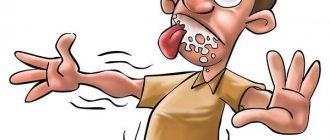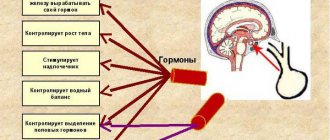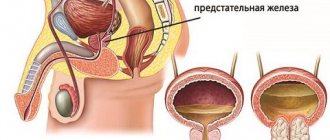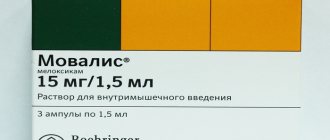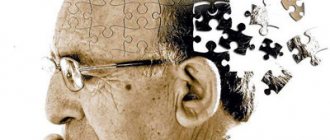- Sleep disturbance
- Convulsions
- Constipation
- Urinary incontinence
- Burning skin
- Skin tingling
- Lameness
- Motor dysfunction
- Leg pain
- Muscle numbness in the affected area
- Decreased skin sensitivity in the lumbar region
- Hypertonicity of the lumbar muscles
Sciatica is not a separate disease, but a whole complex of unpleasant symptoms and sensations that arise under the influence of pressure on one or more components of the sciatic nerve. Most often it occurs where it extends beyond the spine.
- Causes
- Symptoms
- Vertebrogenic lumboischialgia
- Diagnostics
- Treatment methods
- Prevention
What is important is that pain symptoms are felt not only throughout the entire back area, but also at a considerable distance from it. This can be explained by the large length of the nerve. The sciatic nerve is the thickest and longest in the human body. Its branches, consisting of five pairs of spinal nerves, have their endings in the soft tissues of a person - the buttocks and thighs.
Simply put, sciatica occurs when one of the tips of the sciatic nerve, which is normally located in the spine and is responsible for supporting the legs, for some reason becomes irritated, pinched or extends beyond the canal in which it is located.
In addition to the usual form of the disease, there is such a variety as vertebrogenic lumboischialgia. A feeling of pain occurs in one of the parts of the spine.
What is sciatica?
Sciatica (sciatica) is not an independent disease, but a complex of symptoms resulting from compression, irritation or exit from the sciatic nerve canal. Due to the length and branching of the nerve, pain can occur not only at the point of injury, but also at a distance from it.
In the vast majority of cases, sciatica is unilateral. If the disease begins with a lumbago in the lower back, then it is called lumboischialgia.
Types of lumboischialgia
There are several classifications of pathology.
- acute lumbar ischialgia (primarily occurring pain syndrome);
- chronic lumbago with sciatica (acute phases followed by remissions).
Because of its appearance, lumboischialgia is differentiated into types:
- Vertebrogenic or vertebral (associated with diseases of the spine), including: - discogenic (caused by a herniated disc); - spondylogenic (due to osteochondrosis of the spine).
- Nonvertebrogenic, including: - angiopathic (manifests itself when the vessels of the lower limbs and lower back are affected); - myofascial (observed in diseases of the muscles and fascia);
— lumboischialgia with damage to the peritoneal organs;- lumbago with sciatica due to pathologies of the hip joint.
According to the degree of distribution of the pain syndrome, lumboischialgia can be:
- unilateral - radiates to one limb, more pronounced on one side of the lower back: left or right);
- bilateral (bilateral) - appears on both sides of the spine, often radiating to both limbs.
The cause of back pain can also be the development of radicular syndrome. Its types and diagnostic methods.
The history of the disease of alcoholic delirium, or simply “squirrel” in common people, is very extensive and has been known for a long time. What can trigger his attack, and how to help a person, read in this article.
If you are looking for a rehabilitation center for recovery,
we recommend rehabilitation
, where rehabilitation of neurological diseases and chronic pain is carried out, using the most modern methods of physiotherapy.
What is the danger?
The appearance of sciatica should not be taken lightly. She never just appears. Once it appears, it will constantly remind you of itself. The situation will become more complicated from attack to attack, gradually immobilizing the person.
Every movement will cause unbearable pain, difficult to relieve with medications. In particularly severe cases, sciatica can lead to loss of sensitivity and dysfunction of the pelvic organs (fecal and urinary incontinence).
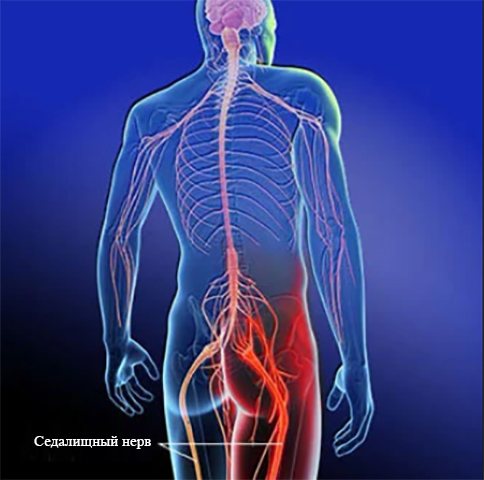
Causes
The development of sciatica occurs against the background of the underlying disease. The level of pain and the likelihood of recovery depend on it. The main reasons causing the development of sciatica include:
- Injuries.
- Protrusions and hernias of the vertebrae.
- Ankylosing spondylitis.
- Spondylolisthesis.
- Spinal stenosis.
- Piriformis syndrome.
- Tumors.
- Pregnancy.
- Thrombosis.
- Diabetes.
- Hypothermia.
- Lifting weights.
All these conditions can cause the development of pathological processes in tissues, and involve the roots of the sciatic nerve.
Risk factors and causes
In most cases, sciatica develops in patients who have impaired integrity of the intervertebral discs in the lumbar region.
The likelihood of developing this pathology increases if the patient:
- suffers from obesity;
- smokes;
- abuses alcohol and drugs;
- leads a sedentary lifestyle and is forced to remain in static positions for a long time.
Eliminating the main risk factors helps prevent the development of sciatica. But there are risk factors whose effects cannot be neutralized. The likelihood of developing pathology is higher in patients who are over 40 years old. This is due to the progression of age-related changes in the spine.
The disease can develop under the influence of such factors:
In almost 90% of cases, the development of sciatica is provoked by the presence of intervertebral hernias . When the core of the intervertebral disc protrudes through the damaged annulus fibrosus, the distance between adjacent vertebrae decreases. As a result, the nerve roots begin to be compressed or pinched.
Consequences
When the sciatic nerve becomes inflamed, the patient begins to feel pain, the intensity of which increases over time. At the same time, the person’s sensation in the legs is impaired, and a feeling of tingling and numbness in the lower back may occur. Over time, muscles weaken.
In cases where the sciatic nerve becomes inflamed due to damage to the spine, loss of sensation in the lower extremities is possible , and paresis or paralysis of the legs develops.
Symptoms
The first and main sign of compression of the sciatic nerve is pain of varying degrees of intensity . It can be either localized in a specific area or spread throughout the entire leg.
In addition to pain, sciatica can manifest itself with the following symptoms:
- Back muscle tension.
- Pain in the gluteal muscles, worse when sitting.
- Tingling or burning in the leg.
- Sensory disturbances (paresthesia, hyperesthesia).
- Movement disorders (weakness in the leg, lameness, immobility).
- Cramps.
- Incontinence of feces and urine.

Symptoms may appear with varying degrees of intensity. The strength of their manifestation directly depends on the severity of the underlying disease.
How to treat the sciatic nerve when it is pinched
One of the largest nerves in the body is the sciatic nerve. How to treat it in case of inflammation or pinching is a question that worries mainly the adult population over 30 years old and pregnant women. It is this category of people who most often suffer from a disease called sciatica (sciatica). The main symptom of damage to the sciatic nerve is pain in the lower back, radiating to the leg.
General information
To understand how to treat inflammation of the sciatic nerve, it is useful to be aware of the causes of its damage, as well as its anatomical location.
The sciatic nerve descends from the lumbosacral plexus (the fourth and fifth lumbar vertebrae). It is covered by the piriformis muscle. It innervates the knee and hip joints.
Further, the nerves are divided into the tibial and tibial nerves (which innervate the lower leg).
Causes of sciatica
A nerve can be pinched, touched or pinched in a variety of ways, not necessarily as a result of a fall or external influence. It can be:
- Mechanical causes (vertebral displacement, hernia, osteochondrosis).
- Temperature (hypothermia).
- Tumors, infections.
- Compression of nerves by hematoma, as well as post-injection abscesses.
- Neuropathy associated with metabolic disorders (alcohol dependence).
- Pregnancy.
Treatment
How to treat inflammation of the sciatic nerve is a question that in case of sciatica needs to be answered as soon as possible. In any case, self-medication is not the answer. After examination and diagnosis, the doctor will write the necessary prescription with a list of required medications.
https://www.youtube.com/watch?v=2oesyhMg2PI
What methods and techniques will help if the sciatic nerve is pinched? It is important to know what to do in cases where severe acute pain occurs and it is not possible to reach a doctor.
First aid for sciatica:
- take a lying position on your stomach, shoulders and head should lie on a pillow, cover yourself with a warm blanket;
- secure your back with a scarf or handkerchief;
- take universal painkillers and antipyretics (Ibuprofen, Indomethacin, Aspirin, Diclofenac);
- avoid drafts.
Correctly provided first aid will help you get to the doctor’s office, who will accurately determine the nature of the disease. So, at the first symptoms of sciatica, drug treatment with the listed remedies can be started independently. The doctor will adjust the dose.
Which doctor should I contact? This should be a neurologist, therapist or chiropractor. You need to be careful when choosing a doctor. The examination will allow the doctor to determine treatment tactics. It is advisable that an x-ray and monogram be taken.
The problem, called inflammation and pinching of the sciatic nerve, the treatment of which must be corrected by a therapist, requires an integrated approach. It will help get rid of pain in the shortest possible time. A combination of medication therapy and various physiotherapeutic procedures is recommended.
Treatment of the disease includes:
Massage
When the sciatic nerve is pinched or inflamed, any type of massage (general, cupping, acupressure) is useful. The procedure helps relieve tension, relieve pain and eliminate discomfort.
Massage together with physiotherapy will help the pain go away faster.
Acupuncture
Acupuncture helps relieve excess tension from tissues. Thin needles are inserted into certain areas of the body. Like massage, this procedure has a beneficial effect on the nerve, restoring its function.
Sciatic nerve block
Many drugs are used to treat the disease. But if they do not help, a blockade is carried out. The blockade technique differs depending on the location of the injury. The procedure is contraindicated during pregnancy, arterial hypotension, a tendency to allergies, myasthenia gravis, or intolerance to the blocking substance. The procedure is designed to prevent the pain impulse from entering the central nervous system.
Exercise therapy
Exercise therapy is prescribed only when the acute phase of the disease has passed, during periods of remission. When practicing physical therapy, attention is initially paid to the fingers and feet.
All exercises are performed smoothly and slowly. When the pain becomes less, the patient is offered other more complex activities.
You can read more in the article - exercises for pinched sciatic nerve.
Some therapeutic exercises
Manual therapy
If you decide to undergo manual therapy, it is important to know that it will be carried out by a competent specialist who has undergone special training. Manual adjustment of the position of the spine is carried out only on a special table.
Surgery
If weakness in the legs progresses, then surgery may be an indication. An alarming sign is when problems with the sciatic nerve are accompanied by loss of bladder and bowel control.
Treatment with medications and physical therapy of the disease is carried out for a period of 6 to 12 weeks. If during this time there is no noticeable improvement, surgical intervention is indicated.
What not to do
- When in the acute stage, it is important to maintain bed rest and physical activity is prohibited.
- It is not recommended to heat the sore spot and massage during the acute phase of the disease, during the period of exacerbation.
- The sitting position should not take more than 2 hours.
- It is highly undesirable to sleep on your back (a more acceptable position is on your side).
- Engage in treatment without indications (drink pills that can harm).
- Sleep on a soft mattress (it should be medium hard)
- Eat haphazardly (with inflammation of the median nerve, patients are advised to adhere to the principles of a healthy diet)
Rehabilitation
During rehabilitation, traditional methods of treatment are often used. It is recommended to continue doing special physical exercises and leading an active lifestyle. Also important:
- control weight;
- monitor your general health;
- if your health worsens, contact your primary care physician;
- eat right (meals should be organized).
For problems related to the sciatic nerve, a device called Denas (promoting dynamic electrical nerve stimulation) can help. With it you can carry out physiotherapy procedures at home. Exercises on special simulators, for example, Bubnovsky, are useful.
You should not suddenly stop exercising, refuse the prescribed diet or other doctor’s prescriptions after your condition improves. It is important that the positive result sticks.
Some exercises using the Bubnovsky method
Treatment at home
Treatment of sciatica at home is recommended with the approval of a doctor. If the patient has no contraindications, he can use the following methods.
- Cupping massage of the lumbosacral region of the spine, as well as the lower leg and inner thigh; In this case, warming ointments are used.
- The bath is their pine needles. A kilogram of pine shoots is poured with 3 liters of boiling water and infused for 4 hours. Then the infusion is poured into a regular bath.
- Compress with beeswax. Warm up and soft wax is kneaded in your hands and applied to the sore spot. You need to put a blanket on top and keep the compress for 1.5–2 hours.
- Rye dough compress. Yeast and rye flour are mixed, the dough should rise and swell in a warm place. After an hour, it should be placed in gauze and on the sore spot.
- Cabbage leaf compress. Cabbage leaves are placed in boiling water for a few minutes, then cooled and applied to the sore spot. A warm scarf is tied on top. The compress should be kept on the sore spot for about 2 hours.
- Rubbing with turpentine. Turpentine ointment is gently rubbed into the areas of pain. Apply the product up to 4 times a day.
- There are other folk remedies, for example, decoctions that need to be taken orally. But compresses, baths and massage are the main methods of traditional medicine against sciatica.
Complications
Sometimes when a nerve is compressed, blood vessels are compressed. In this case, the tissues do not receive sufficient nutrition, which can lead to complications.
The task with sciatica is to prevent the death of nerve fibers. This can have dire consequences, even causing the person to become disabled. This situation happens in advanced cases when the nerve endings have already atrophied.
Paralysis can be a dangerous complication. It develops with prolonged numbness and loss of control of the leg. The person does not feel the lower limb.
If the cause of nerve damage is a serious infection (tuberculosis, pleurisy), disorders such as urinary and fecal incontinence may develop.
It is important to remember that the disease can develop quickly or slowly. But its course and elimination depend on the joint actions of the doctor and the patient. Self-medication for a pinched sciatic nerve is unacceptable. During an acute attack, it is important to behave correctly and not make sudden movements.
Diagnostics
To make an accurate diagnosis, consultation with a neurologist is necessary. The basis for diagnosing sciatica is:
- Blood and urine tests (general and biochemical).
- X-ray, CT, MRI.
- Electroneurography (ENG) and electromyography (EMG).
Laboratory tests of blood and urine show the level of inflammation and the degree of immune response in concomitant diseases, and indicators of hardware research methods visualize spinal pathologies.
ENG and EMG procedures are not prescribed to all patients. In doubtful cases, when it is difficult to accurately determine the location, duration and extent of nerve damage, ENG and EMG may be more effective research methods. In addition, these procedures can be used to monitor the effectiveness of the selected treatment regimen.
Establishing diagnosis
Sciatica is diagnosed using several methods. The most common option is radiography. The main advantage of this method is its simplicity and speed. In addition, this examination allows you to accurately determine the presence of inflammation of the sciatic nerve. But this method cannot be used during pregnancy, in restless patients and in obesity, since it will be almost impossible to see the vertebrae in the pictures.
Another method that allows you to accurately determine the presence of sciatica is computer diagnostics. Computer diagnostics, unlike the first method, allows you to most accurately determine the presence of this disease. However, it is contraindicated for pregnant women.
Magnetic resonance imaging is the optimal diagnostic method that can determine the presence of sciatic neuralgia.
It is usually used in cases where the inflammatory process occurs in the spinal cord, in its membranes and surrounding soft tissues. This method allows you to study the condition of soft tissues. But this method is not allowed to be used if there are metal implants. Using MRI, you can identify the causes of sciatica that cannot be identified with computer diagnostics and radiography.
Treatment
Therapy should begin with eliminating the root cause. But, since treatment of the underlying disease may take several months, it is necessary to help the person cope with pain and restore lost functions. For these purposes, a combined treatment regimen , including physiotherapy and painkillers and anti-inflammatory medications.
Physiotherapeutic treatment methods:
- UHF.
- Diadynamic therapy.
- Aplipulse therapy.
- Neurostimulation.
- Phonophoresis.
- Massotherapy.
- Acupuncture.
- Vacuum therapy.
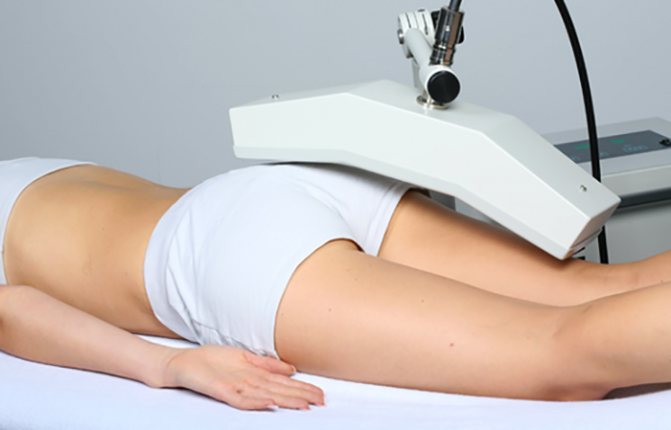
Physiotherapy using currents has a number of limitations and contraindications. It is not recommended to carry out these treatment methods without consulting your doctor.
Drug therapy includes taking drugs from the NSAID (Diclofenac, Indomethacin, Ibuprofen), painkillers (Renalgin, Analgin), vitamins B, C, E, as well as epidural injections of steroid drugs, and various types of injection blockades.
In the acute period, drugs of the NSAID group and painkillers are prescribed in the form of injections. As the pain subsides, a transition to the tablet form is made.
In severe cases, when conservative treatment methods do not bring results, you have to resort to surgical intervention. If sciatica is caused by a herniated disc, a microdiscectomy , and if there is severe stenosis, a laminectomy . Surgical treatment methods also include neurolysis and suturing of the sciatic nerve trunk. All these procedures are quite traumatic, and do not always live up to the expectations placed on them. That is why they are resorted to only in extreme cases.
Providing medical care
Treatment of sciatica is aimed at achieving the following goals:
- release of compressed nerve endings;
- elimination of pain syndrome;
- relief from muscle spasms;
- improving the state of trophism of muscle and nervous tissues, metabolic processes;
- cleansing the cell structure of harmful substances, toxins and waste;
- healing of the entire spine, lower extremities and pelvic organs.
During the treatment of sciatic neuralgia (sciatica), complex treatment is carried out, which consists of the following methods - drug therapy, physiotherapy, exercises that can be performed independently at home.
Treatment of the sciatic nerve is carried out using the following methods and drugs (in the form of blockades, injections, oral administration):
- the patient is advised to ensure rest, all stress should be kept to a minimum;
- It is imperative to take analgesics to reduce pain;
- non-steroidal anti-inflammatory drugs are taken, which reduce the inflammatory process in the affected area, reduce the pressure of the nerve roots;
- additionally, manual manipulation is used, which is a decisive factor in all medical therapy;
- acupuncture procedure;
- the use of manual massage in the lower back, buttocks, thighs, legs and feet;
- use of reflexology;
- conducting a course of therapeutic exercises;
- Additionally, you can use ointments and preparations with a warming effect;
- treatment using leeches - hirudotherapy;
- physiotherapy;
- water aerobics;
- yoga classes.
Therapeutic blockade of the sciatic nerve for neuralgia:
Special exercises for the sciatic nerve for sciatica that can be performed at home:
Treatment at home
The basis of home treatment for sciatica is various types of rubbing and compresses.
- 100 g of acacia flowers + 300 ml of vodka, leave in a warm place for 1 week. Strain the resulting mixture. Rub into the affected area as needed.
- Mix honey and black radish juice in a 3:1 ratio. Rub the resulting mixture onto the sore area until completely absorbed. The course of treatment is 7-10 days.
- Knead the dough from 1 cup of flour and 1-2 tablespoons of warm honey. Form the dough into a flat cake and apply it to the sore spot overnight. The cake must be covered with polyethylene and secured with a bandage. The course of treatment is 7-10 days.
- Mix turpentine and water in a 1:2 ratio. Moisten a long piece of bread with the resulting solution and apply it to the sore spot. Wrap in plastic. The procedure takes no more than 10-15 minutes to avoid burns.
These and many other traditional medicine recipes relieve pain by improving local blood circulation. But, they are not able to eliminate the main cause of compression. Treatment with folk remedies must be agreed with your doctor.

